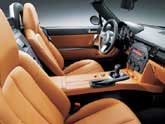Recent Articles
Popular Makes
Body Types
2006 Mazda MX-5 Miata First Drive
Mazda’s redesigned roadster is King of fun little cars
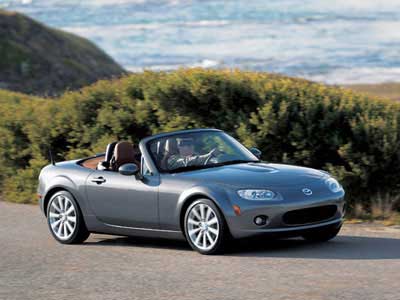
If you’re up for a challenge, try this: redesign an icon that owns a spot in the as the best-selling two-seater sports car in the world, one that is to this day loved and cherished around the globe. Should you take on such an endeavor, the best place to start would be at the end: If you were on the Mazda team that spent two years rethinking the Miata, you would look backward to leap forward, a jump that would start with the metaphor of , the spirit of the “horse and rider” as one, derived from an ancient Japanese competition in which a rider shoots arrows at a target while galloping at speed. You did say you were up for a challenge, right? So if that’s not enough, add in this brain buckler: engineer your third-generation 2006 MX-5 Miata in a way that replicates the performance of the successful first and second editions, yet has no parts in common. Give it the same basic shape and design, but make it notable in its differences, all the while making sure old – car and driver as one – is alive and well. Which is exactly what they did. With this complete redesign, Mazda adhered to the core principle of , having ridden the horse and struck the target with uncanny precision. The 2006 Mazda MX-5’s technological intelligence, bigger interior and exterior, improved safety, upgraded features, and great performance successfully marries its past to its future, a strategy sure to keep the newest Miata in the enviable position as the top-selling sports car in the world, loved by enthusiasts around the globe.
What’s New?
What’s New? Though it rides on a dedicated platform with no carry-over parts from the previous Miata, engineers working on the third-generation 2006 Mazda MX-5 did look back to its original DNA to replicate the styling, driving, cornering, braking, sound and interior touch points (such as materials, the shape and feel of gear knobs, and switches) that made it so successful.
Though it rides on a dedicated platform with no carry-over parts from the previous Miata, engineers working on the third-generation 2006 Mazda MX-5 did look back to its original DNA to replicate the styling, driving, cornering, braking, sound and interior touch points (such as materials, the shape and feel of gear knobs, and switches) that made it so successful. In addition, the Miata’s engineering team borrowed a few styling cues and technologies from Mazda’s big brother, the RX-8. And, while Mazda used exacting measurements to evaluate each performance parameter, the most important area of feedback considered was subjective “performance feel,” a character hard to quantify although engineers wired a test driver to his Miata to monitor and measure behavior changes during different driving experiences in an effort to create hard design and engineering targets.
With a concentration on craftsmanship and consistency, the Miata’s designers used the newest materials and methods to restrict the weight gain inherent to the larger exterior and interior packaging, keeping the net bump in mass to just 22 lbs. – not bad given the engineering requirements necessary to meet new safety and emissions standards. Other updates improve torsional rigidity (body stiffness is increased by more than forty percent); craft a top that is easier to open and close (one latch replaces two and it’s easier to drop and raise with one hand); and increase performance (such as a lighter clutch flywheel and a stiffened drive shaft). Although the powertrain is also improved, Mazda engaged in extensive debate about the appropriate sound coming from the twin exhaust outlets, considering 59 different tuning frequencies before settling on a note that can immediately be recognized as an MX-5 from 15 feet away.
By sliding the engine rearward 5.3 inches, Mazda was also able to balance the MX-5 with a near 50/50 weight distribution, just as Honda has done with the S2000. The engine now sits behind the front axle and also contributes to the Miata’s low center of gravity, which helps it stay planted on the road. Increases in length and height are negligible, but the wheelbase has been stretched by 2.5 inches and the width by 1.7 inches, which you’ll feel as greater cabin room. Compared to an S2000, the Honda measures five inches longer than the Miata’s 157.3-inch length, and the wheelbase reaches 2.8 inches farther. At 37.4 inches, the Mazda’s headroom is much better than the 34.6 inches of an S2000, but legroom still trails the Honda by 1.2 inches. In terms of styling, the rise and fall of the new Miata’s front fenders clearly emulates the shape of the Mazda RX-8. From the front, however, the resemblance is not as conspicuous, as the uncreased upper front fascia houses smooth parallelogram-shaped headlights. A subtle bump in the center of the hood pleasantly accentuates the performance potential underneath, and on the flanks, larger door handles that pull upward are new and ergonomically appealing. The rear clip preserves the familiar Miata look, modernized with clear taillight lenses, flared fenders, and a pronounced crease on the back edge of the trunk lid. Miatas now hold 5.3 cubic feet of cargo, a bit more than the 5 cubic feet swallowed by an S2000.
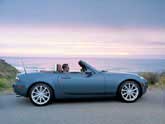
Miata History
Miata History The first Miata made its public debut in America at the Chicago Auto Show, in February of 1989, and went on sale in July, as a 1990 model. Today, more than 700,000 Miatas have been sold around the world, and more than half a million are still running strong. The Mazda Miata has a 16-year history on the road, although Mazda’s engineers began to study the development of a lightweight sports car in 1983. The first Miata made its public debut in America at the Chicago Auto Show in February of 1989, and went on sale in July as a 1990 model. It featured a 116-horsepower, 1.6-liter four-cylinder engine, backed by a five-speed manual transmission. With a curb weight just over 2,100 lbs., this two-seat roadster was an instant success, and 23,052 units were sold by year’s end.
The next year saw the addition of a four-speed automatic, and eventually a Special Edition British Racing Green version complete with tan leather upholstery arrived to great fanfare. For the 1994 model year, dual airbags and better structural bracing were added, in addition to more displacement (1.8 liters) and horsepower (128).
An all-new second generation Miata surfaced in 1999, including a fresh design and glass rear window while preserving the Miata essence of ‘zoom-zoom’ that was now heralded throughout the world. A performance-tuned Mazdaspeed MX-5 Miata arrived in 2004, with 178 horsepower pumped out of a turbocharged 1.8-liter engine. But by then, Mazda had sold over 300,000 Miatas in the U.S. alone, securing this lightweight roadster as a classic and not simply a passing fancy. Today, more than 700,000 Miatas have been sold around the world, and more than half a million are still running strong.
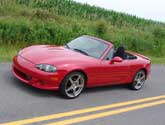
Model Mix
Model Mix Mazda sells the 2006 Miata MX-5 in several trims with three different transmissions, uniquely tuned suspensions, exterior and interior options, and even special colors. Although all 2006 Mazda MX-5 Miatas use the same engine, there are several trim models with three different transmissions, uniquely tuned suspensions, exterior and interior options, and even special colors. Base versions – named Club Spec after the limited-edition models that were sold primarily to SCCA racers – are available only with a five-speed manual transmission behind the universally applied 2.0-liter inline four-cylinder engine. Priced starting at $20,995, Club Spec models include black cloth-trimmed upholstery; a CD player with speed-sensitive volume control and four speakers; power windows, locks, and mirrors; a tilt steering wheel; four-wheel disc brakes with ABS; 16-inch alloy wheels on 205/50 series tires; and a black vinyl top. Club Spec models are only available in Winning Blue Metallic, True Red, and Marble White.
Spending another $1,000 gets you an MX-5 with a leather-wrapped steering wheel and air conditioning as standard equipment, drops the Club Spec designation, and adds five additional colors to the paint palette. Touring models cost another grand at $22,995, and come fitted with cruise control, keyless entry, steering-wheel-mounted audio and cruise controls, silver seatback trim, halogen fog lights, and the option of a six-speed automatic transmission with paddle shifters. At $23,495, the Sport arrives with a standard six-speed manual transmission but the six-speed automatic is optional. Sport models also add a front suspension tower brace, 17-inch wheels with 205/45 series tires and a leather-wrapped shift knob. Grand Touring versions run another $1,500 at $24,995, replacing the vinyl roof with a cloth top and the cloth upholstery with leather seating. Both the top and seats are available in either black or tan. Other additions include a Bose seven-speaker audio system, an alarm and silver door speaker trim.
Both the Sport and Grand Touring models equipped with the six-speed manual may be fitted with a Suspension Package that includes a sport-tuned suspension with upgraded Bilstein shocks and a limited-slip rear differential. A Premium Package, available only on Grand Touring Miatas, includes xenon headlights, dynamic stability control with traction control, the limited slip differential, and a Smart Key keyless ignition system included with the burglar alarm. Run-flat tires measuring 205/45R17 are also available with Sport and Grand Touring vehicles, and as before, a hardtop is optional on any MX-5 Miata. Mazda will build 750 “3rd Generation Limited” special edition models priced at $27,260. In addition to the full features on the Grand Touring model, Limited versions wear an exclusive Velocity Red exterior color, matching red or black leather interior, special 17-inch wheels, a leather-wrapped parking brake lever, and chrome trim inside and out. The interior also includes a badge with individual numbering. Mazda will build 3,500 of the special edition models for the entire world, with 750 designated for the U.S.
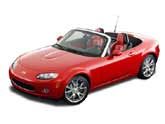
Nuts and Bolts
Nuts and Bolts While the 2006 Mazda MX-5 Miata’s powerplant displacement remains constant, the output varies slightly depending on which gearbox is chosen. With a manual, the motor makes 170 horsepower. With the optional automatic, the rating drops to 166 horsepower. While the 2006 Mazda MX-5 Miata’s powerplant displacement remains constant, the output varies slightly depending on which gearbox is chosen. With either the five- or six-speed manual, the 2.0-liter inline-four yields 170 horsepower at 6,700 rpm. Going with the automatic six-speed lowers the power rating a tad, summoning only 166 horsepower. Despite the slightly lower power rating, we were thoroughly impressed with this automatic gearbox and its crisp power, especially when shifting gears manually. All versions of this engine develop 140 lb.-ft. of torque at 5,000 rpm and redline at 7,000 rpm. In contrast, last year’s 1.8-liter mill made only 142 horsepower and 125 lb.-ft. of torque.
Cast aluminum heads and block, dual overhead cams, and variable intake valve timing contribute to the little four’s performance. While this engine pales in comparison to the 240-horse, 2.2-liter four-cylinder that Honda uses in its S2000 roadster, remember that the Honda starts at $33,150. A better match price-wise is the MINI Cooper convertible, which delivers 115 horsepower from its naturally aspirated 1.6-liter four or 168 horsepower in the supercharged Cooper S. Prices for the Mini begin close to $21,500 for the Cooper convertible and $24,950 for the supercharged S, although the Mini is more of a sprightly four-seat runabout and is not a true roadster.
The three Miata transmissions all have a final drive ratio of 4.100:1. Each varies in gearing, with the five-speed manual and six-speed automatic hitting 1:1 ratios in fourth gear and the six-speed manual matching this ratio in fifth gear. The six-speed automatic achieves a lofty 0.582:1 in sixth gear. Paddle shifting is available as an option on six-speed automatic versions of the Touring, Sport and Grand Touring models. All Miatas deliver power to the rear wheels and come with an independent multi-link rear suspension setup that complements a double wishbone front design. Aluminum is used extensively to help reduce unsprung weight for better handling. Stabilizer bars and gas-filled monotube dampers are standard, with upgraded Bilsteins shocks optional. Rack-and-pinion steering requires just 2.6 turns lock-to-lock thanks to a 15.0:1 steering ratio. Four-wheel-disc brakes with ABS include 11.4-inch ventilated front rotors and 11-inch solid rear rotors, the fronts having grown by almost one inch.
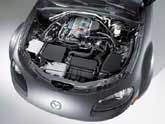
Safety and Technology
Safety and Technology Regardless of the trim chosen, each 2006 Mazda MX-5 Miata arrives standard with dual front airbags with a passenger-side deactivation switch, side impact airbags with torso and head protection, and seatbelts with pretensioners and force limiters. Regardless of the trim chosen, each 2006 Mazda MX-5 Miata arrives standard with dual front airbags with a passenger-side deactivation switch, side impact airbags with torso and head protection, and seatbelts with pretensioners and force limiters. Tire pressure monitoring is included on Sport, Grand Touring, and Limited models, but only when the optional run-flat tires are chosen. In addition to increased torsional rigidity, the Miata’s A-pillars have been strengthened to withstand heavier loads, in the event of a rollover collision. A knee bolster is also designed into the cowl for occupant protection. The Miata has never been a gadgetry flagship, but features such as stability control, high-intensity discharge headlights, and a limited-slip rear differential are available on the 2006 model. Components such as the six-speed automatic transmission and variable intake valve timing on the engine also support Mazda’s technological advancement with the value-priced MX-5 Miata Club Spec.
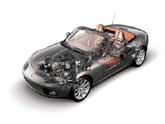
Driving Impressions
Driving Impressions Hitting the apex of the fun-to-drive curve, the 2006 Mazda MX-5 Miata truly stands apart from the crowd, delivering big grins no matter what speed it’s traveling. Hitting the apex of the fun-to-drive curve, the 2006 Mazda MX-5 Miata proves the adage that sometimes it is more fun to drive a slow car fast than a fast car slow. Not that the new MX-5 is exactly slow, but it’s no powerhouse either. Rather, joy is derived because you can drive it at 60 mph and get the sound and steering sensations of driving 100 mph.
We drove three different versions of the new Miata over a course of 180 miles and, despite the speed limitations on the Big Island of Hawai’i, we were able to hustle the new drop-top the way many everyday enthusiasts will drive it. The first thing we noticed is the Miata’s exhaust note, which is more like the original model in emitting a slightly more robust gurgle when you accelerate with vigor or reach the higher end of the rev range. Next, we discovered the Miata’s improved pedal placement and operation. The pedals are set up the same distance apart, with similar rates of travel to accomplish your mission and accommodate easy heel-and-toe motoring with the manual transmission. Weighted to feel more responsive and set up at a slightly different height, the revised pedals make driving the Miata more fun.
Underway, it’s clear that the Miata’s ride comfort is improved, and that the slightly wider cockpit feels bigger than before. Modernized, but not loaded down with gadgetry, the interior is refreshingly simple. The dash has contemporary look and the materials are pleasing. The sun visors disappoint, appearing to be made of low-grade plastic and Lilliputian in dimension. Driving positions proved adequate for people measuring both 6’0” and 5’2” thanks to an adjustable steering wheel, added seat travel, and increased hip and leg room. Interior stowage is slightly increased but still nominal at best, although both the glove box and the trunk are enlarged. Noteworthy are cupholders in the center console and on the doors, positioned to make maneuvering the gear selector easier. There’s also a new coin holder. Wind management is improved with the top down and road noise has been reduced, allowing for easier conversation while driving.
We drove Miatas equipped with both the six-speed manual and the automatic tranny with paddle shifting. While we strongly prefer to row our own gears and enjoy the ability to run into the red, Mazda’s work to reduce shift shock when the automatic transmission downshifts is apparent, and we were particularly impressed by the rev-matching throttle ‘blip’ when the automatic selected a lower gear. Plus, the automatic features faster, smoother upshifting. Miatas that shift for you are no longer a performance penalty box.
We found the short-throw six-speed manual a delight to operate, but slightly notchy and not as well synchronized as we had expected. However, it is important to note that the Miatas we were driving were pre-production models and this could also be a ‘break-in’ issue. The retuned rack-and-pinion steering is weighted somewhat light for slow speed maneuvering, but thankfully stiffens as the pace quickens, and responds in an intuitive, connected fashion.
Improved cornering stability comes from bigger contact patches where the Miata-specific performance rubber meets the road, as well as the new Miata’s improved ability to transfer weight with its new five-link rear suspension. Increased torsional rigidity, half-shafts that are the same weight as the previous version but are thicker and stronger so that they twist more and bend less, and a lighter flywheel also contribute to a lively, nimble feel. Knowledge gained from Mazda’s racing program results in a new drive shaft, and bigger brakes with larger rotors and stiffer calipers are nearly perfect at stopping the Miata in a graduated and linear manner. In fact, Mazda engineers say that the new brakes, which are similar to the RX-8’s, are best in class, and can out-brake the Porsche 911 in comparison testing.
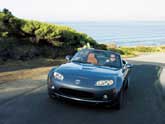
Wrap Up
Wrap Up Thanks to its utter competence and sheer fun-to-drive nature, not to mention our tropical surroundings, the MX-5 allowed us to soak up Hawaiian vibes like few other cars on the planet. Over the years, competitors have attempted to decode Mazda’s philosophy, from Ford with the ill-fated Mercury Capri to Toyota with the fast-fading MR2 Spyder. And though the Miata arguably spawned a roadster renewal in America, paving the way to success for the BMW Z3 and Z4, the Honda S2000, the Mercedes-Benz SLK, and the Porsche Boxster, it has needed to fend off few direct competitors on price, design, and performance. Until now. General Motors is gearing up a factory in Delaware that has begun spitting out 2006 Pontiac Solstices, a less expensive, more powerful, and exotically sultry roadster that will provide the MX-5 Miata with the stiffest competition it’s ever had to face. And following the Solstice for 2007 is the Saturn Sky, an equally compelling two-seater with added luxury features. But until rabid customer desire is sated for the Pontiac and Saturn (did we just write that sentence!?), the Solstice and Sky are likely to be in scarce supply – leaving the MX-5 Miata as a fine alternative. And what a fine alternative it is. Thanks to its utter competence and sheer fun-to-drive nature, not to mention our tropical surroundings, the MX-5 allowed us to soak up Hawaiian vibes like few other cars on the planet. The size of the specially made tires that shod the MX-5 didn’t matter. We stopped caring how many logarithms or test specs created the new Miata’s gallop and go. The scent of jasmine came on a sea breeze. The sun warmed our cheeks like liquid Vitamin C. The bucket seat became a saddle and our muscles knew intuitively what to do. There were wisps of a dream, a blur of vivid colors, and we were propelled fast, then faster, then galloping. One with our surroundings. One with the car. . Either that, or some kick-ass Mazda public relations Kool Aid.
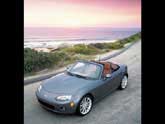
Specifications
Specifications The 2006 Mazda MX-5 Miata competes against the BMW Z4 2.5i, Chrysler Crossfire Roadster, Honda S2000, Mercedes-Benz SLK 280, Mini Cooper Convertible, Nissan 350Z Roadster, Pontiac Solstice, Saturn Sky, Volkswagen New Beetle Convertible Test Vehicle: 2006 Mazda MX-5 Price Range: $20,995 (Club Spec) to $27,260 (Limited Edition) (including a destination charge of $560) Engine Size and Type: 2.0-liter inline four-cylinder Engine Horsepower: 170 at 6,700 rpm (manual); 166 at 6,700 rpm (automatic) Engine Torque: 140 lb.-ft. at 5,000 rpm Transmission: Ffive-speed manual; six-speed manual; six-speed automatic Curb weight, lbs.: 2,441 - 2,527 EPA Fuel Economy (city/highway): 24-25/30 mpg (both MTs); 23/30 mpg (AT) mpg Length: 157.3 inches Width: 67.7 inches Wheelbase: 91.7 inches Height: 49 inches Head room: 37.4 inches Leg room: 43.1 inches Max. Seating Capacity: two Cargo Volume: 5.3 cubic feet Competitors: BMW Z4 2.5i, Chrysler Crossfire Roadster, Honda S2000, Mercedes-Benz SLK 280, Mini Cooper Convertible, Nissan 350Z Roadster, Pontiac Solstice, Volkswagen New Beetle Convertible
Photos courtesy of Mazda North American Operations
